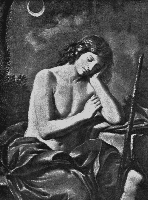|
MYTH MAN'S HOMEWORK
HELP
Selene is the moon goddess, daughter of the Titan Hyperion and the Titaness Theia (or her mother was Euryphaessa, according to others). She is the sister of Eos (Dawn), Helios (Sun) and Titan. With Zeus she had Pandia, an exceedingly beautiful woman, and two other daughters. With Endymion she begat fifty daughters and the handsome Narcissus, whose beauty led to a tragic end. Selene is known for her countless love affairs. The most famous of her loves is the shepherd Endymion (see Thomas Bullfinch below). Other affairs of Selene's include involvement with Zeus and also Pan who gave her a herd of white oxen. Pan accomplished the seduction of Selene by disguising his hairy black goatishness with white fleece. Selene consented to ride on his back, unaware of who he was, and Pan proceeded to ravish her. Some sources report that the Nemean lion, which fell to the earth from the moon, was the result of an affair of Zeus and Selene, and that she had given birth to the monster on Mount Tretus. Others say that the Moon Goddess created the lion out of sea foam enclosed in a large ark at the request of Hera, and that Iris enclosed it in her magic girdle and bore it with a fearful shudder, dropping it on earth. You see, as punishment for a promised sacrifice that was not fulfilled, Selene set it to prey upon the people who dared dishonor her, the story goes. They were called Bambinaeans, and they were terrorized by the beast until Heracles (Hercules) came along and subdued it. Selene was identified with the goddess of the hunt Artemis, another "moon goddess" of spring and summer, and Athena, the "moon goddess" of autumn and summer. She's portrayed as a young woman with an extremely white face who travels on a silver chariot drawn by two horses. Also she is often shown riding a horse or a bull. Selene is said to wear robes, carry a torch, and wear a half moon on her head. After her brother Helios completes his journey across the sky, she begins hers. But before Selene journeys across the night sky she bathes in the sea. The seduction of Endymion is the love affair that brings Selene the most fame. Selene fell in love with the very handsome Endymion, who was allowed to choose what he would, and he chose to sleep for ever, remaining deathless and ageless. However some say that he chose to be always sleepless. Since Selene was so deeply in love with Endymion she asked Zeus to allow him to decide his own fate. Zeus granted Selene's request, and Endymion chose never to grow old and to sleep eternally. However, Endymion's eternal sleep did not prevent him from Selene giving birth to his daughters. Endymion was visited by Selene every night and softly kissed by her rays of light. Here is the story of
Endymion as told by Endymion was a beautiful youth who fed his flock on Mount Latmos. One calm, clear night Diana, the moon (Selene), looked down and saw him sleeping. The cold heart of the virgin goddess was warmed by his surpassing beauty, and she came down to him, kissed him, and watched over him while he slept. Another story was that Jupiter (Zeus) bestowed on him the gift of perpetual youth united with perpetual sleep (Hypnos). Of one so gifted we can have but few adventures to record. Diana, it was said, took care that his fortunes should not suffer by his inactive life, for she made his flock increase, and guarded his sheep and lambs from the wild beasts. The story of Endymion has a peculiar charm from the human meaning which it so thinly veils. We see in Endymion the young poet, his fancy and his heart seeking in vain for that which can satisfy them, finding his favourite hour in the quiet moonlight, and nursing there beneath the beams of the bright and silent witness the melancholy and the ardour which consume him. The story suggests aspiring and poetic love, a life spent more in dreams than in reality, and an early and welcome death. The "Endymion" of Keats is a wild and fanciful poem, containing some exquisite poetry, as this, to the moon: "...The sleeping
kine Dr. Young, in the "Night Thoughts," alludes to Endymion thus: "...These
thoughts, O Night, are thine; Fletcher, in the "Faithful Shepherdess," tells: "How the pale
Phoebe, hunting in a grove,
|


